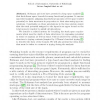Free Online Productivity Tools
i2Speak
i2Symbol
i2OCR
iTex2Img
iWeb2Print
iWeb2Shot
i2Type
iPdf2Split
iPdf2Merge
i2Bopomofo
i2Arabic
i2Style
i2Image
i2PDF
iLatex2Rtf
Sci2ools
ESOP
2009
Springer
2009
Springer
Amortised Memory Analysis Using the Depth of Data Structures
Hofmann and Jost have presented a heap space analysis [1] that finds linear space bounds for many functional programs. It uses an amortised analysis: assigning hypothetical amounts of free space (called potential) to data structures in proportion to their sizes using type annotations. Constraints on these annotations in the type system ensure that the total potential assigned to the input is an upper bound on the total memory required to satisfy all allocations. We describe a related system for bounding the stack space requirements which uses the depth of data structures, by expressing potential in terms of maxima as well as sums. This is achieved by adding extra structure to typing contexts (inspired by O’Hearn’s bunched typing [2]) to describe the form of the bounds. We will also present the extra steps that must be taken to construct a typing during the analysis. Obtaining bounds on the resource requirements of programs can be crucial for ensuring that they enjoy reliability an...
ESOP 2009 | Heap Space Analysis | Linear Space Bounds | Programming Languages | Stack Space Requirements |
Related Content
| Added | 19 May 2010 |
| Updated | 19 May 2010 |
| Type | Conference |
| Year | 2009 |
| Where | ESOP |
| Authors | Brian Campbell |
Comments (0)

